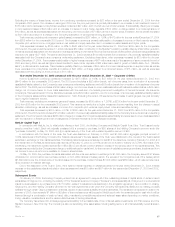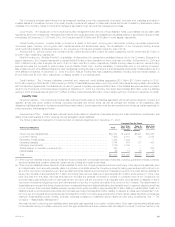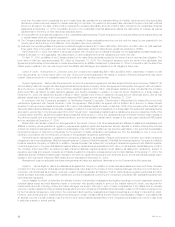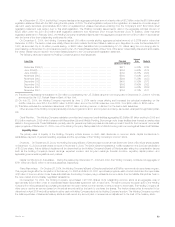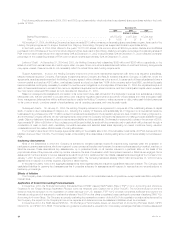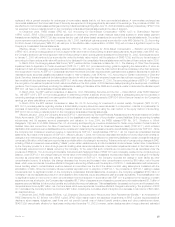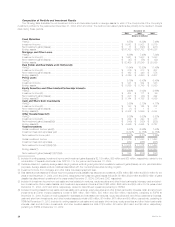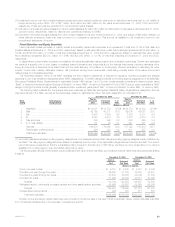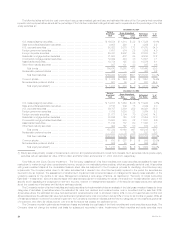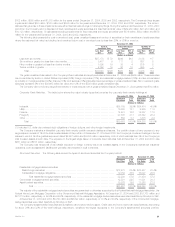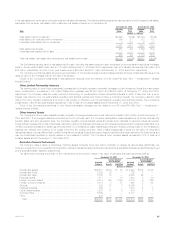MetLife 2004 Annual Report Download - page 28
Download and view the complete annual report
Please find page 28 of the 2004 MetLife annual report below. You can navigate through the pages in the report by either clicking on the pages listed below, or by using the keyword search tool below to find specific information within the annual report.replaces it with a general exception for exchanges of nonmonetary assets that do not have commercial substance. A nonmonetary exchange has
commercial substance if the future cash flows of the entity are expected to change significantly as a result of the exchange. The provisions of SFAS 153
are effective for nonmonetary asset exchanges occurring in fiscal periods beginning after June 15, 2005 and shall be applied prospectively. SFAS 153 is
not expected to have a material impact on the Company’s consolidated financial statements at the date of adoption.
In December 2004, FASB revised SFAS No. 123 Accounting for Stock-Based Compensation (‘‘SFAS 123’’) to Share-Based Payment
(‘‘SFAS 123(r)’’). SFAS 123(r) provides additional guidance on determining whether certain financial instruments awarded in share-based payment
transactions are liabilities. SFAS 123(r) also requires that the cost of all share-based transactions be recorded in the financial statements. The revised
pronouncement must be adopted by the Company by July 1, 2005. As all stock options currently accounted for under APB Opinion No. 25, Accounting
for Stock Issued to Employees (‘‘APB 25’’) will vest prior to the effective date, implementation of SFAS 123(r) will not have a significant impact on the
Company’s consolidated financial statements.
Effective January 1, 2003, the Company adopted SFAS No. 148, Accounting for Stock-Based Compensation — Transition and Disclosure
(‘‘SFAS 148’’), which provides guidance on how to apply the fair value method of accounting for share-based payments. As permitted under SFAS 148,
the Company elected to use the prospective method of accounting for stock options granted subsequent to December 31, 2002. Options granted prior
to January 1, 2003 will continue to be accounted for under the intrinsic value method until the adoption of SFAS 123(r), and the pro forma impact of
accounting for these options at fair value will continue to be disclosed in the consolidated financial statements until the last of those options vest in 2005.
In March 2004, the Emerging Issues Task Force (‘‘EITF’’) reached further consensus on Issue No. 03-1, The Meaning of Other-Than-Temporary
Impairment and Its Application to Certain Investments (‘‘EITF 03-1’’). EITF 03-1 provides accounting guidance regarding the determination of when an
impairment of debt and marketable equity securities and investments accounted for under the cost method should be considered other-than-temporary
and recognized in income. An EITF 03-1 consensus reached in November 2003 also requires certain quantitative and qualitative disclosures for debt and
marketable equity securities classified as available-for-sale or held-to-maturity under SFAS No. 115, Accounting for Certain Investments in Debt and
Equity Securities, that are impaired at the balance sheet date but for which an other-than-temporary impairment has not been recognized. The Company
has complied with the disclosure requirements of EITF 03-1 which were effective December 31, 2003. The accounting guidance of EITF 03-1 relating to
the recognition of investment impairment which was to be effective in the third quarter of 2004 has been delayed pending the development of additional
guidance. The Company is actively monitoring the deliberations relating to this issue at the FASB and currently is unable to determine the ultimate impact
EITF 03-1 will have on its consolidated financial statements.
In March 2004, the EITF reached consensus on Issue No. 03-6, Participating Securities and the Two — Class Method under FASB Statement
No. 128 (‘‘EITF 03-6’’). EITF 03-6 provides guidance in determining whether a security should be considered a participating security for purposes of
computing earnings per share and how earnings should be allocated to the participating security. EITF 03-6 did not have an impact on the Company’s
earnings per share calculations or amounts.
In March 2004, the EITF reached consensus on Issue No. 03-16, Accounting for Investments in Limited Liability Companies (‘‘EITF 03-16’’).
EITF 03-16 provides guidance regarding whether a limited liability company should be viewed as similar to a corporation or similar to a partnership for
purposes of determining whether a noncontrolling investment should be accounted for using the cost method or the equity method of accounting.
EITF 03-16 did not have a material impact on the Company’s consolidated financial statements.
Effective January 1, 2004, the Company adopted SOP 03-1, as interpreted by Technical Practices Aids issued by the American Institute of Certified
Public Accountants. SOP 03-1 provides guidance on (i) the classification and valuation of long-duration contract liabilities; (ii) the accounting for sales
inducements; and (iii) separate account presentation and valuation. In June 2004, the FASB released FSP No. 97-1, Situations in Which
Paragraphs 17(b) and 20 of FASB Statement No. 97, Accounting and Reporting by Insurance Enterprises for Certain Long-Duration Contracts and for
Realized Gains and Losses from the Sale of Investments, Permit or Require Accrual of an Unearned Revenue Liability (‘‘FSP 97-1’’) which included
clarification that unearned revenue liabilities should be considered in determining the necessary insurance benefit liability required under SOP 03-1. Since
the Company had considered unearned revenue in determining its SOP 03-1 benefit liabilities, FSP 97-1 did not impact its consolidated financial
statements. As a result of the adoption of SOP 03-1, effective January 1, 2004, the Company decreased the liability for future policyholder benefits for
changes in the methodology relating to various guaranteed death and annuitization benefits and for determining liabilities for certain universal life insurance
contracts by $4 million, which has been reported as a cumulative effect of a change in accounting. This amount is net of corresponding changes in DAC,
including VOBA and unearned revenue liability (‘‘offsets’’) under certain variable annuity and life contracts and income taxes. Certain other contracts sold
by the Company provide for a return through periodic crediting rates, surrender adjustments or termination adjustments based on the total return of a
contractually referenced pool of assets owned by the Company. To the extent that such contracts are not accounted for as derivatives under the
provisions of SFAS No. 133, Accounting for Derivative Instruments and Hedging Activities (‘‘SFAS 133’’) and not already credited to the contract account
balance, under SOP 03-1 the change relating to the fair value of the referenced pool of assets is recorded as a liability with the change in the liability
recorded as policyholder benefits and claims. Prior to the adoption of SOP 03-1, the Company recorded the change in such liability as other
comprehensive income. At adoption, this change decreased net income and increased other comprehensive income by $63 million, net of income
taxes, which were recorded as cumulative effects of changes in accounting. Effective with the adoption of SOP 03-1, costs associated with enhanced or
bonus crediting rates to contractholders must be deferred and amortized over the life of the related contract using assumptions consistent with the
amortization of DAC. Since the Company followed a similar approach prior to adoption of SOP 03-1, the provisions of SOP 03-1 relating to sales
inducements had no significant impact on the Company’s consolidated financial statements. At adoption, the Company reclassified $155 million of
ownership in its own separate accounts from other assets to fixed maturities, equity securities and cash and cash equivalents. This reclassification had
no significant impact on net income or other comprehensive income at adoption. In accordance with SOP 03-1’s guidance for the reporting of certain
separate accounts, at adoption, the Company also reclassified $1.7 billion of separate account assets to general account investments and $1.7 billion of
separate account liabilities to future policy benefits and policyholder account balances. This reclassification decreased net income and increased other
comprehensive income by $27 million, net of income taxes, which were reported as cumulative effects of changes in accounting. The application of SOP
03-1 decreased the Company’s 2004 net income by $67 million, including the cumulative effect of adoption of a decrease in net income of $86 million
as described above.
In December 2003, FASB revised SFAS No. 132, Employers’ Disclosures about Pensions and Other Postretirement Benefits — an Amendment of
FASB Statements No. 87, 88 and 106 (‘‘SFAS 132(r)’’). SFAS 132(r) retains most of the disclosure requirements of SFAS 132 and requires additional
disclosure about assets, obligations, cash flows and net periodic benefit cost of defined benefit pension plans and other postretirement plans.
SFAS 132(r) was primarily effective for fiscal years ending after December 15, 2003; however, certain disclosures about foreign plans and estimated
MetLife, Inc. 25




